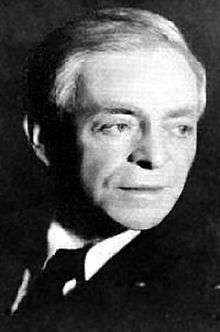Casimir Funk
| Casimir Funk | |
|---|---|
 | |
| Born |
Kazimierz Funk February 23, 1884 Warsaw, Congress Poland |
| Died |
November 19, 1967 (aged 83) New York, NY, U.S. |
| Citizenship |
Poland United States |
| Nationality | Polish |
| Fields | Biochemist |
| Institutions |
Pasteur Institute Lister Institute Funk Foundation for Medical Research |
| Alma mater | University of Bern, Switzerland |
| Known for | Nutritional research, formulation of the concept of vitamins |
Kazimierz Funk[1] [kaˈʑimjɛʂ ˈfuŋk] (February 23, 1884 – November 19, 1967[2]), commonly anglicized as Casimir Funk, was a Polish biochemist,[3] generally credited with being among the first to formulate (in 1912) the concept of vitamins,[4] which he called "vital amines" or "vitamines".[5]
Achievements
After reading an article by the Dutchman Christiaan Eijkman that indicated that persons who ate brown rice were less vulnerable to beri-beri than those who ate only the fully milled product, Funk tried to isolate the substance responsible, and he succeeded. Because that substance contained an amine group, he called it "vitamine". It was later to be known as vitamin B3 (niacin), though he thought that it would be thiamine (vitamin B1) and described it as "anti-beri-beri-factor". In 1911 he published his first paper in English, on dihydroxyphenylalanine. Funk was sure that more than one substance like Vitamin B1 existed, and in his 1912 article for the Journal of State Medicine, he proposed the existence of at least four vitamins: one preventing beriberi (“antiberiberi”); one preventing scurvy (“antiscorbutic”); one preventing pellagra (“antipellagric”); and one preventing rickets (“antirachitic”). From there, Funk published a book, The Vitamines, in 1912, and later that year received a Beit Fellowship to continue his research.
Funk proposed the hypothesis that other diseases, such as rickets, pellagra, coeliac disease, and scurvy could also be cured by vitamins.[6]
Funk was an early investigator of the problem of pellagra. He suggested that a change in the method of milling corn was responsible for the outbreak of pellagra,[7] but no attention was paid to his article on this subject.[8]
The "e" at the end of "vitamine" was later removed, when it was realized that vitamins need not be nitrogen-containing amines.
He postulated the existence of other essential nutrients, which became known as vitamins B1, B2, C, and D.
In 1936 he determined the molecular structure of thiamine, though he was not the first to isolate it.
Funk also conducted research into hormones, diabetes, peptic ulcers, and the biochemistry of cancer.
After returning to the United States, in 1940 he became president of the Funk Foundation for Medical Research. He spent his last years studying the causes of neoplasms ("cancers").
Umetaro Suzuki had in 1910 succeeded in extracting a water-soluble complex of micronutrients from rice bran and had named it "aberic acid", but the German translation, unlike the Japanese original, had failed to note that it was a newly discovered nutrient.
Funk Award
The Polish Institute of Arts and Sciences of America (PIASA) annually honors Polish-American scientists with the Casimir Funk Natural Sciences Award. Past winners have included Nobel Laureate Roald Hoffmann, Aleksander Wolszczan, Hilary Koprowski, Peter T. Wolczanski, Wacław Szybalski, and Benoît Mandelbrot.
See also
Notes
- ↑ Iłowiecki, Maciej (1981). Dzieje nauki polskiej (History of Polish Science). Warszawa: Wydawnictwo Interpress. p. 177. ISBN 83-223-1876-6.
- ↑ (English) Griminger P Casimir Funk A Biographical Sketch (1884–1967). Journal of Nutrition 1972 Sep;102(9):1105–13. PMID 4560436. Available from: http://jn.nutrition.org/content/102/9/1105.full.pdf
- ↑ Casimir Funk denied his Jewish identity, according to his granddaughter
- ↑ Just The Facts-Inventions & Discoveries, School Specialty Publishing, 2005
- ↑ http://www.jinfo.org/Biomedical_Scientists.html
- ↑ Casimir Funk, The etiology of the deficiency diseases. Beri-beri, polyneuritis in birds, epidemic dropsy, scurvy, experimental scurvy in animals, infantile scurvy, ship beri-beri, pellagra. In: Journal of State Medicine 20, 1912, pp. 341–68.
- ↑ Funk, C (1913). "Studies on pellagra. The influence of the milling of maize on the chemical composition and nutritive value of the meal". J Physiol. 47: 389–392. doi:10.1113/jphysiol.1913.sp001631.
- ↑ Alfred, JAY Bollet (1992). "Politics and Pellagra: The Epidemic of Pellagra in the U.S. in the Early Twentieth Century" (PDF). The Yale Journal of Biology and Medicine. 65: 211–221.
Further reading
| Wikimedia Commons has media related to Casimir Funk. |
- Harow, Benjamin CASIMIR FUNK-Pioneer in Vitamins and Hormones. Dodd, Mead & Company, New York,N. Y., 1955. 209 pages.
- Biography
- Review of Harow's biography at pubmedcentral, pdf
- Biography at FAQs, nutrition accessed Dec 2006.
- Piro, Anna; Tagarelli, Giuseppe; Lagonia, Paolo; Tagarelli, Antonio; Quattrone, Aldo (1 January 2010). "Casimir Funk: His Discovery of the Vitamins and Their Deficiency Disorders". Annals of Nutrition and Metabolism. 57 (2): 85–88. doi:10.1159/000319165.
- Griminger, Paul (September 1972). "Casimir Funk--a biographical sketch (1884-1967)". Journal of Nutrition. 102 (9): 1105–1113.
- "Funk, Casimir", Complete Dictionary of Scientific Biography, vol. 5, Detroit, Charles Scribner's Sons, 2008 pp. 208–9. Gale Virtual Reference Library. Web. 19 July 2012.